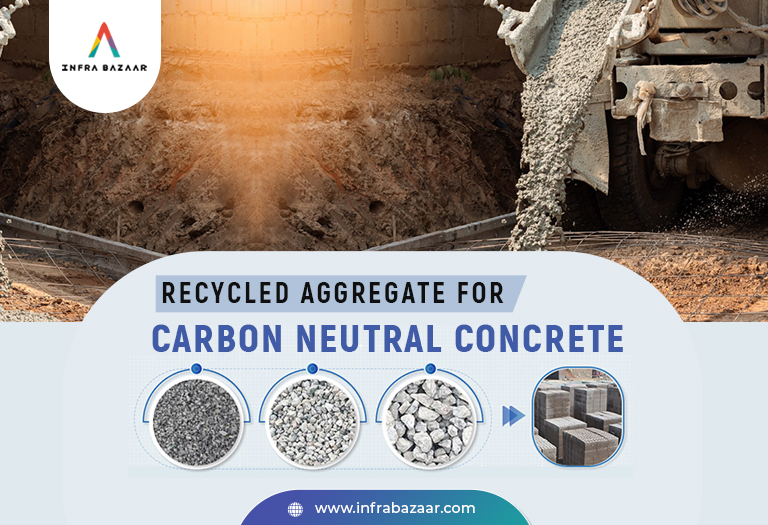
Posted By:Infra Bazaar
Building materials are progressively evaluated by their ecological factors. Concrete recycling has gained significance in recent times since it eradicates the requirement for disposal and protects natural resources by utilizing readily obtainable concrete as an aggregate source for novel concrete.
Considering the extent to which construction materials can contribute to global climate change and other environmental problems, carbon-neutral concrete has obtained importance. In this blog, we will explain everything associated with recycled aggregate for carbon-neutral concrete.
Why Concrete?
The construction industry comprises a considerable development factor for emerging economies. However, it parallelly contributes to waste generation as well because several materials related to industrial sectors are utilized. These include ceramics, plastics, aluminum, wood, glass, cardboard, stone, steel, and cement.
Building materials like concrete are increasingly being interrogated for their impact on the environment mainly because demolition and construction waste are key constituents of the waste produced by the industry.
Implementations
Generally, the uses without any processing are:
Several processes are helpful for removing contaminants, which include air separation, screening, size reduction, and selective demolition. Posterior removal of contaminants, crushed concrete can be utilized as bridge foundations, gutters, curbs, sidewalks, median barriers, shoulders, and pavements.
Characteristics of Recycled Aggregate
Recycled concrete aggregates consist of the original aggregates as well as hydrated cement paste. The latter augments the porosity and decreases the particular gravity in comparison with similar virgin aggregates. Moreover, a high RCA (recycled concrete aggregate) porosity results in more absorption as well.
Commonly, it is accepted that while utilizing natural sand, a maximum of 30% of natural crushed coarse aggregate can be substituted for coarse recycled aggregate without having a significant impact on the concrete’s mechanical characteristics. For such mixing processes, Infrabazaar recommends the utilization of a second-hand concrete mixing vehicle in order to ensure high sustainability.
In general, it is suggested that recycled concrete aggregate should be batched in a previously wetted and nearly saturated surface dry situation, similar to lightweight ones. In order to obtain the same water-cement ratio, slump, and function as conventional concrete, the amount of water or paste content reducer should be augmented.
RCA can be compacted, placed, and transported just as conventional concrete. Nonetheless, when it comes to utilizing fine RCA, special care is crucial. A maximum of 10-20% of fine RCA is considered to be advantageous. Also, the aggregate must be tested at various rates of substitution to evaluate the optimum rate.
In various instances, recycled aggregate and virgin aggregate are combined while being utilized in novel concrete.
Recycled Aggregate - A Sustainable Choice
Recycling concrete offers sustainability in a number of ways. The mere recycling process decreases the amount of material that needs to be added to landfills. The concrete becomes aggregate by itself and all embedded metals are ready for removal and recycling. Moreover, since the requirement for landfills reduces, the project’s overall economic effect reduces as well. At Infrabazaar, we thus believe that recycled aggregate is a better choice since our focus lies on making eco-friendly decisions and helping contractors reduce their carbon footprint.
Apart from the above-mentioned, recycled concrete aggregates decrease the requirement for virgin aggregates. Thus, the overall environmental impact associated with the process of extracting aggregates is also reduced. Through the removal of novel material production and waste disposal requirements, transportation needs for the entire project decrease significantly.
Furthermore, recycled concrete aggregates absorb a great amount of major greenhouse gas - CO2 - from the surrounding environment. As a matter of fact, carbonation takes place in all concrete from inward surfaces. During the process of crushing it for creating recycled aggregates, surfaces of concrete that do not carbonate are exposed to the carbon dioxide present in the air.
The Bottom Line
Considering the impact that the construction industry has on the environment, it is crucial to take into account as many ways as possible to reduce this impact and make conscious choices towards carbon neutral constructions. Although there are certain ways that have been proven to be greatly useful, contractors must definitely consider using recycled concrete aggregate for carbon-neutral concrete, adding to the sustainability of their project and helping the environment significantly. Since concrete recycling is a relatively easy process, this is the best solution and a big step for the country to attain its goal of zero carbon footprint
#RecycledAggregate #CarbonNeutralConcrete #SustainableConstruction #ConcreteRecycling #EcoFriendlyBuildingMaterials #EnvironmentallyFriendlyConstruction #Infrabazaar